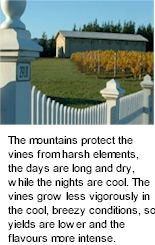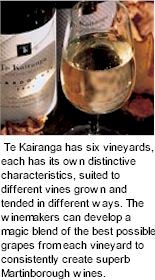


The wine region of Martinborough is located at the foot of New Zealand's North Island at a latitude of 40 degrees south. Here, a happy coincidence of geology and geography has created the perfect climate and terrain for Pinot Noir and aromatic wines. The stone-filled river terraces are free-draining while the topsoils vary from slope to slope. The mountains protect the vines from harsh elements, the days are long and dry, while the nights are cool. The vines grow less vigorously in the cool, breezy conditions, so yields are lower and the flavours more intense.

The long dry autumns provide the right balance of warm days (creating ripeness) and cool nights (providing elegance) for producing top quality Pinot Noir and other early-ripening varieties. The results speak for themselves – the Martinborough region is known internationally for consistently producing world-class fine wines. Te Kairanga has six vineyards here. Each has its own distinctive characteristics, suited to different vines grown and tended in different ways. This means the winemakers can develop a magic blend of the best possible grapes from each vineyard to consistently create quality, premium wines for you to enjoy.
The Te Kairanga vineyards are positioned to maximise the conditions which make Martinborough the perfect state of wine. There are four Te Kairanga vineyards on the highly-acclaimed Martinborough Terrace. They are planted at the highest point of the terrace with the deepest gravels. The free-draining structure coupled with the area’s low rainfall, means the vines can be stress managed to achieve richness and fruit intensity in the wines.
The terrace is at its deepest and stoniest at its eastern end, the site of the Draper or home vineyard. This is where you’ll find the estate's oldest vines (in fact, the first vines planted in Martinborough were planted here). The vineyard – home to Pinot Noir, Chardonnay and Sauvignon Blanc varieties – is named after TK founder, Tom Draper. The 32-hectare East Plain Vineyard is split up into six blocks. Two recently planted blocks, Martins Road and Todds Road, are producing excellent quality Pinot Noir on young vines, and already contribute to the Te Kairanga Runholder Pinot Noir.

The Angle Block is a small parcel on the home site which consistently delivers the core fruit for Te Kairanga Reserve Chardonnay. It crops low and delivers fruit of wonderful intensity with white peach, melon and citric characters. The small McLeod Vineyard consistently delivers Pinot Noir of the highest quality and is managed to contribute to the John Martin blend. The fruiting wire height is only 600mm above the ground (normal height around 700mm) and this has improved the quality of grapes harvested. The Sutherland vineyard is a more recent planting, first cropped in 2005. This block has the potential to deliver exceptional fruit of John Martin quality.
At an altitude of 100m, and with a north-south row orientation, Springrock Vineyard has excellent exposure to the morning sun due to the east sloping nature of the natural fan. This ensures a long ripening period with harvests often two weeks after the home vineyards. The result is strong characteristics coming through the fruit which show blackberry and distinctive white pepper with higher acidity while tannins remain soft. Pinot Noir and Chardonnay are the varietals at Springrock. Think of Springrock when you enjoy Te Kairanga Reserve Chardonnay and Estate, Runholder and John Martin Pinot Noir. You can be sure they are made with care and respect for the place from which they came.
The 44-hectare Ruakokoputuna vineyard is located in a narrow valley south of Martinborough. The climate is distinctly different here. The hills shade the valley creating cooler temperatures that delay bud burst, flowering and fruit set in spring and ripening and harvest in autumn. In summer though, the hills trap the heat. This results in the highest summer temperatures of all the Te Kairanga vineyards and greater extremes of day and night temperatures over the ripening period. The relatively high altitude (180 metres above sea level) also contributes to the cool climate characteristics of the Sauvignon Blanc and Pinot Noir varieties we grow here. You can taste the classic cool climate fruit intensity of Ruakokoputuna when you savour Te Kairanga Sauvignon Blanc and the Estate, Runholder or John Martin Pinot Noir.
Te Kairanga Cellar Door sales are in The Cottage – the home of John Martin’s senior stockman, built over 140 years ago. It is a classic farm cottage design of its time made from totara wood milled from the farm. It has housed several local personalities as well as the wonderful New Zealand poet Sam Hunt. Recently it featured on a New Zealand produced television programme. Literally thousands of people from all four corners of the world visit The Cottage every year and it is central to the success of the major events held annually.
